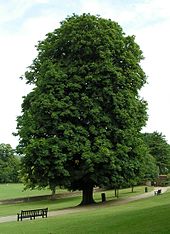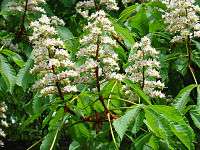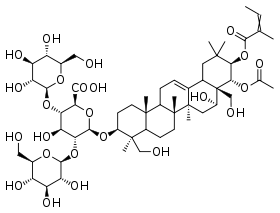Aesculus hippocastanum
Aesculus hippocastanum is a species of flowering plant in the soapberry and lychee family Sapindaceae. It is a large deciduous, synoecious[2] (hermaphroditic-flowered) tree, commonly known as horse-chestnut[3] or conker tree.
| Aesculus hippocastanum | |
|---|---|
 | |
| Scientific classification | |
| Kingdom: | Plantae |
| Clade: | Tracheophytes |
| Clade: | Angiosperms |
| Clade: | Eudicots |
| Clade: | Rosids |
| Order: | Sapindales |
| Family: | Sapindaceae |
| Genus: | Aesculus |
| Species: | A. hippocastanum |
| Binomial name | |
| Aesculus hippocastanum | |
 | |
| Native distribution | |
Description
Aesculus hippocastanum is a large tree, growing to about 39 metres (128 ft) tall[4]:371 with a domed crown of stout branches; on old trees the outer branches are often pendulous with curled-up tips. The leaves are opposite and palmately compound, with 5–7 leaflets; each leaflet is 13–30 cm (5–12 in) long, making the whole leaf up to 60 cm (24 in) across, with a 7–20 cm (3–8 in) petiole. The leaf scars left on twigs after the leaves have fallen have a distinctive horseshoe shape, complete with seven "nails". The flowers are usually white with a yellow to pink blotch at the base of the petals;[4] they are produced in spring in erect panicles 10–30 cm (4–12 in) tall with about 20–50 flowers on each panicle. Its pollens are not poisonous for honey bees.[5] Usually only 1–5 fruits develop on each panicle; the shell is a green, spiky capsule containing one (rarely two or three) nut-like seeds called conkers or horse-chestnuts. Each conker is 2–4 cm (3⁄4–1 1⁄2 in) in diameter, glossy nut-brown with a whitish scar at the base.[6]


Etymology
The common name "horse-chestnut" (often unhyphenated) is reported as having originated from the erroneous belief that the tree was a kind of chestnut (though in fact sweet chestnuts are from a different family, the Fagaceae), together with the alleged observation that the fruit or seeds could help panting or coughing horses.[7][8]
Distribution and habitat
Aesculus hippocastanum is native to a small area in the Pindus Mountains mixed forests and Balkan mixed forests of South East Europe.[9] However, it can be found in many parts of Europe as far north as Gästrikland in Sweden, as well as in many parks and cities in the northern United States and Canada.
Uses
It is widely cultivated in streets and parks throughout the temperate world, and has been particularly successful in places like Ireland, Great Britain and New Zealand, where they are commonly found in parks, streets and avenues. Cultivation for its spectacular spring flowers is successful in a wide range of temperate climatic conditions provided summers are not too hot, with trees being grown as far north as Edmonton, Alberta, Canada,[10] the Faroe Islands,[11] Reykjavík, Iceland and Harstad, Norway.
In Britain and Ireland, the seeds are used for the popular children's game conkers. During the First World War, there was a campaign to ask for everyone (including children) to collect horse-chestnuts and donate them to the government. The conkers were used as a source of starch for fermentation using the Clostridium acetobutylicum method devised by Chaim Weizmann to produce acetone for use as a solvent for the production of cordite, which was then used in military armaments. Weizmann's process could use any source of starch, but the government chose to ask for conkers to avoid causing starvation by depleting food sources. But conkers were found to be a poor source, and the factory only produced acetone for three months; however, they were collected again in the Second World War for the same reason.[12]

The seeds, especially those that are young and fresh, are slightly poisonous, containing alkaloid saponins and glucosides. Although not dangerous to touch, they cause sickness when eaten; consumed by horses, they can cause tremors and lack of coordination.[13]
Though the seeds are said to repel spiders there is little evidence to support these claims. The presence of saponin may repel insects but it is not clear whether this is effective on spiders.[14]
Horse-chestnuts have been affected by the leaf-mining moth Cameraria ohridella, whose larvae feed on horse chestnut leaves. The moth was described from North Macedonia where the species was discovered in 1984 but took 18 years to reach Britain.[15]
The flower is the symbol of the city of Kyiv, capital of Ukraine.[16] Although the horse-chestnut is sometimes known as the buckeye, this name is generally reserved for the New World members of the genus Aesculus.
In Germany, horse-chestnuts are often found in beer gardens, particularly in Bavaria. Prior to the advent of mechanical refrigeration, brewers would dig cellars for lagering. To further protect the cellars from the summer heat, they would plant chestnut trees, which have spreading, dense canopies but shallow roots which would not intrude on the caverns. The practice of serving beer at these sites evolved into the modern beer garden.[17]
Medical uses
The seed extract standardized to around 20 percent aescin (escin) is used for its venotonic effect, vascular protection, anti-inflammatory and free radical scavenging properties.[18][19] Primary indication is chronic venous insufficiency.[19][20] A Cochrane Review suggested that horse chestnut seed extract may be an efficacious and safe short-term treatment for chronic venous insufficiency, but definitive randomized controlled trials had not been conducted to confirm the efficacy.[21]
Safety in medical use
Two preparations are considered: whole horse chestnut extract (whole HCE) and purified β-aescin. Historically, whole HCE has been used both for oral and IV routes (as of 2001). The rate of adverse effects is low; in a large German study, 0.6%, consisting mainly of gastrointestinal symptoms. Dizziness, headache and itching have been reported. One serious safety issue is rare cases of acute anaphylactic reactions, presumably in a context of whole HCE.
Another is the risk of acute kidney injury, "when patients, who had undergone cardiac surgery were given high doses of horse chestnut extract i.v. for postoperative oedema. The phenomenon was dose dependent as no alteration in kidney function was recorded with 340 μg/kg, mild kidney function impairment developed with 360 μg/kg and acute kidney injury with 510 μg/kg".[22] This almost certainly took place in a context of whole HCE.
Three clinical trials were since performed to assess the effects of aescin on kidney function. A total of 83 subjects were studied; 18 healthy volunteers given 10 or 20 mg iv. for 6 days, 40 in-patients with normal kidney function given 10 mg iv. two times per day (except two children given 0.2 mg/kg), 12 patients with cerebral oedema and normal kidney function given a massive iv. dose on the day of surgery (49.2 ± 19.3 mg) and 15.4 ± 9.4 mg daily for the following 10 days and 13 patients with impaired kidney function due to glomerulonephritis or pyelonephritis, who were given 20–25 mg iv. daily for 6 days. "In all studies renal function was monitored daily resorting to the usual tests of renal function: blood urea nitrogen (BUN), serum creatinine, creatinine clearance, urinalysis. In a selected number of cases paraaminohippurate and labelled EDTA clearance were also measured. No signs of development of renal impairment in the patients with normal renal function or of worsening of renal function in the patients with renal impairment were recorded." It is concluded that aescin has excellent tolerability in a clinical setting.[23]
Raw horse chestnut seed, leaf, bark and flower are toxic due to the presence of esculin and should not be ingested. Horse chestnut seed is classified by the FDA as an unsafe herb.[19] The glycoside and saponin constituents are considered toxic.[19]
Other chemicals
Quercetin 3,4'-diglucoside, a flavonol glycoside can also be found in horse chestnut seeds.[24] Leucocyanidin, leucodelphinidin and procyanidin A2 can also be found in horse chestnut.
Anne Frank tree
A fine specimen of the horse-chestnut was the Anne Frank tree in the centre of Amsterdam, which she mentioned in her diary and which survived until August 2010, when a heavy wind blew it over.[25][26] Eleven young specimens, sprouted from seeds from this tree, were transported to the United States. After a long quarantine in Indianapolis, each tree was shipped off to a new home at a notable museum or institution in the United States, such as the 9/11 Memorial Park, Central H.S. in Little Rock, and two Holocaust Centers. One of them was planted outdoors in March 2013 in front of the Children's Museum of Indianapolis, where they were originally quarantined.[27]
Diseases
_in_Parma%2C_Italy.jpg)
- Bleeding canker. Half of all horse-chestnuts in Great Britain are now showing symptoms to some degree of this potentially lethal bacterial infection.[30][31]
- Guignardia leaf blotch, caused by the fungus Guignardia aesculi
- Wood rotting fungi, e.g. such as Armillaria and Ganoderma
- Horse-chestnut scale, caused by the insect Pulvinaria regalis
- Horse-chestnut leaf miner, Cameraria ohridella, a leaf mining moth.[32] Also affecting large numbers of UK trees.[31]
- Phytophthora bleeding canker, a fungal infection.[33]
Gallery
 Horse-chestnut planted as a feature tree in a park
Horse-chestnut planted as a feature tree in a park Leaves and trunk
Leaves and trunk Foliage and flowers
Foliage and flowers Close-up of flowers
Close-up of flowers Trunk
Trunk Germination on lawn
Germination on lawn
References
- Allen, D.J.; Khela, S. (2017). "Aesculus hippocastanum" [errata version published in 2018]. IUCN Red List of Threatened Species. IUCN. 2017: e.T202914A122961065. Retrieved 27 September 2019.
- "Aesculus hippocastanum: Reproduction". Archived from the original on 2015-01-30.
- "BSBI List 2007". Botanical Society of Britain and Ireland. Archived from the original (xls) on 2014-10-23. Retrieved 2014-10-17.
- Stace, C. A. (2010). New Flora of the British Isles (Third ed.). Cambridge, U.K.: Cambridge University Press. ISBN 9780521707725.
- Bee trees – Horse chestnut (aesculus hippocastanum)
- Rushforth, K. (1999). Trees of Britain and Europe. Collins ISBN 0-00-220013-9.
- Lack, H. Walter. "The Discovery and Rediscovery of the Horse Chestnut" (PDF). Arnoldia. 61 (4).
- Little, Elbert L. (1994) [1980]. The Audubon Society Field Guide to North American Trees: Western Region (Chanticleer Press ed.). Knopf. p. 541. ISBN 0394507614.
- "Aesculus hippocastanum". Euro+Med Plantbase Project. Archived from the original on September 28, 2007.
- Edmonton
- Højgaard, A., Jóhansen, J., & Ødum, S. (1989). A century of tree planting on the Faroe Islands. Ann. Soc. Sci. Faeroensis Supplementum 14.
- "Conkers - collected for use in two world wars". Making history. BBC. Retrieved 27 September 2014.
- Lewis, Lon D. (1995). Feeding and care of the horse. Wiley-Blackwell. ISBN 9780683049671. Retrieved 2011-10-21.
- Edwards, Jon (2010). "Spiders vs conkers: the definitive guide". Royal Society of Chemistry. Archived from the original on 2013-09-06. Retrieved 2013-09-09.
- Lees, D.C.; Lopez-Vaamonde, C.; Augustin, S. 2009. Taxon page for Cameraria ohridella Deschka & Dimic 1986. In: EOLspecies, http://www.eol.org/pages/306084. First Created: 2009-06-22T13:47:37Z. Last Updated: 2009-08-10T12:57:23Z.
- Kiev
- Schäffer, Albert (2012-05-21). "120 Minuten sind nicht genug" [120 minutes aren't enough]. Frankfurter Allgemeine Zeitung (in German). Retrieved 2016-10-11.
- Diehm, C.; Trampisch, H. J.; Lange, S.; Schmidt, C. (1996). "Comparison of leg compression stocking and oral horse-chestnut seed extract therapy in patients with chronic venous insufficiency". Lancet. 347 (8997): 292–4. doi:10.1016/s0140-6736(96)90467-5. PMID 8569363.
- Horse Chestnut, Memorial Sloan-Kettering Cancer Center
- "Horse Chestnut". National Center for Complementary and Integrative Health. May 2006. Retrieved October 24, 2019.
- Pittler MH, Ernst E. (2012). "Horse chestnut seed extract for chronic venous insufficiency". Cochrane Database Syst Rev. 11: CD003230. doi:10.1002/14651858.CD003230.pub4. PMC 7144685. PMID 23152216.
- Parfitt, Kathleen (1999). Martindale: The complete drug reference.: Das komplette Arzneimittelverzeichnis. pp. 1543–4. ISBN 085369429X.
- Sirtori CR (September 2001). "Aescin: pharmacology, pharmacokinetics and therapeutic profile". Pharmacol. Res. 44 (3): 183–193. doi:10.1006/phrs.2001.0847. PMID 11529685.
- Wagner, J. (1961). "Quercetin-3,4?-diglukosid, ein Flavonolglykosid des Roßkastaniensamens". Die Naturwissenschaften. 48 (2): 54. doi:10.1007/BF00603428.
- Sterling, Toby (24 August 2010). "Anne Frank's 'beautiful' tree felled by Amsterdam storm". The Scotsman. Retrieved 24 August 2010.
- Gray-Block, Aaron (23 August 2010). "Anne Frank tree falls over in heavy wind, rain". Reuters. Archived from the original on 24 August 2010. Retrieved 24 August 2010.
- Pamela Engel (24 March 2013). "Saplings from Anne Frank's tree take root in US". Retrieved 26 July 2018 – via Yahoo News.
- D'Cruz, Mark. "Ma-Ke Bonsai Care Guide for Aesculus hippocastanum". Ma-Ke Bonsai. Archived from the original on 2012-03-15. Retrieved 2011-07-05.
- "Thujoy Khreshchatyk". Why Kyivans miss chestnuts and how they became a symbol of the capital, Ukrayinska Pravda (29 May 2019) (in Ukrainian)
- "Extent of the bleeding canker of horse chestnut problem". UK Forestry Commission. Archived from the original on 2009-12-09. Retrieved 2010-01-09.
- "Other common pest and disease problems of horse chestnut". UK Forestry Commission. Archived from the original on 2009-12-09. Retrieved 2010-01-09.
- "Bleeding Canker". Royal Horticultural Society. 11 November 2009. Archived from the original on 16 January 2010. Retrieved 2010-01-09.
External links
| Wikimedia Commons has media related to Aesculus hippocastanum. |
| Wikispecies has information related to Aesculus hippocastanum |
- NCCIH.nih.gov Horse Chestnut page
- NIH.gov Horse Chestnut page
- Eichhorn, Markus (October 2010). "The Conker Tree (Horse Chestnut)". Test Tube. Brady Haran for the University of Nottingham.

